
By John Reed, Research Professor & Chief Scientist - Harbor Branch Oceanographic Institute at Florida Atlantic University
May 22, 2017
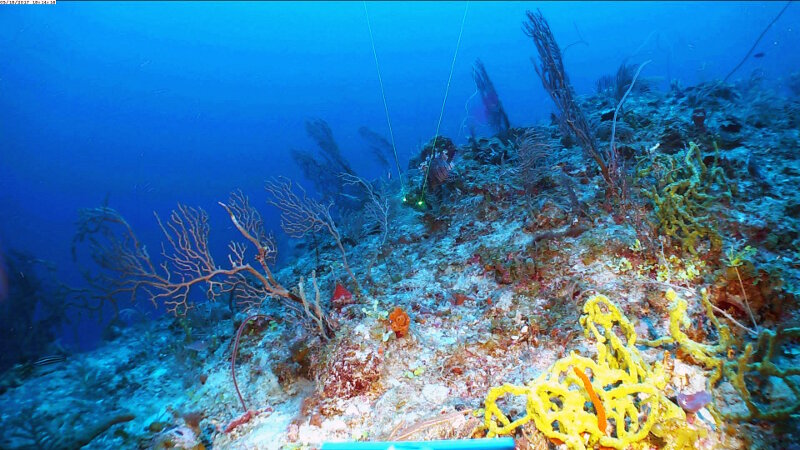
The top of the reef wall at 45 meters depth is covered in a diverse array of sponges (rope sponges, Iotrochota birotulata; orange stalked sponges, Axinellidae), gorgonians (brown sea fan, Iciligorgia schrammi), black whip corals (Stichopathes), and scleractinian corals. Image courtesy of Cuba’s Twilight Zone Reefs and Their Regional Connectivity. Download larger version (jpg, 498 KB).
For the first four days of the cruise, we worked along the northwest coast of Cuba, visiting for the first time the deep reefs between Havana and Guanahacabibes at the western tip, a distance of 190 nautical miles. Shallow-water reefs fringe nearly this entire distance, and it now appears likely that mesophotic depth reefs also may occur over this entire region.
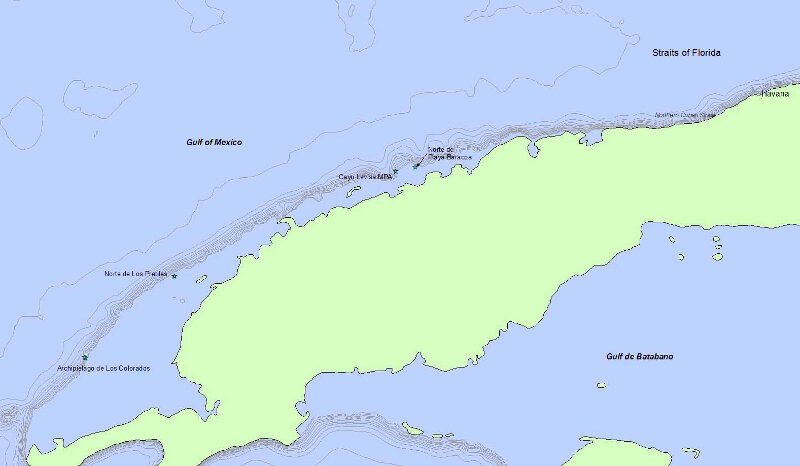
Map north side. Image courtesy of Cuba’s Twilight Zone Reefs and Their Regional Connectivity. Download larger version (jpg, 116 KB).
Our remotely operated vehicle (ROV) dives were in the marine protected area (MPA) “Los Pretiles,” and two areas in the process to become MPAs: “Cayo Levisa” and Archipelago “Los Colorados” (see map). Our dives ranged from depths of 175 meters to 40 meters. The general geomorphology and biology of the sites in this region consisted of four zones.
The Deep Island Slope (175 to 125 meters) is a steep carbonate slope (~60°), with smooth rock substrate and few ledges. The dominant fauna are various sponges and black corals, but diversity and density of organisms is much lower than the mesophotic zone. Among the deepest areas, the sponges are dominated by unknown encrusting forms, but decrease in relative abundance at shallower depths, where a large diversity of massive and branching large sponges are common.
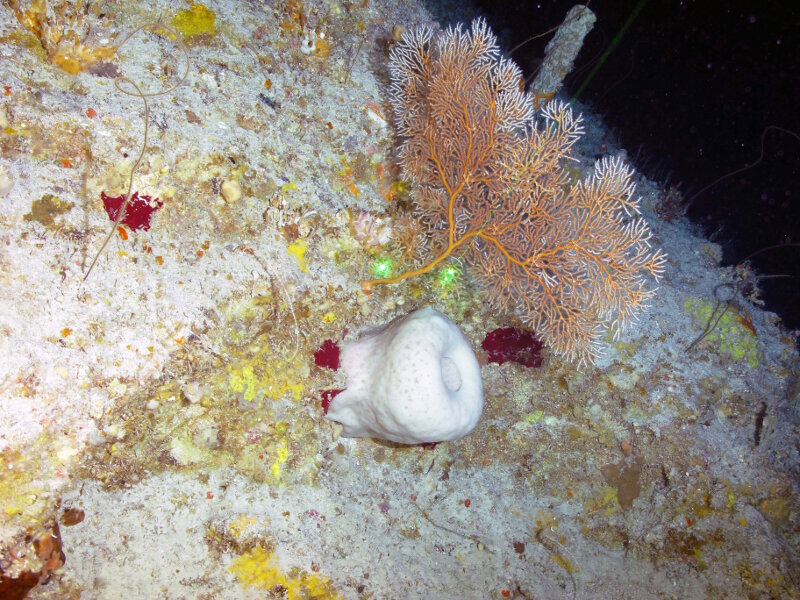
A sea fan Nicella goreaui and vase sponge Xestospongia sp. found along one of the many small ledges in the lower mesophotic zone (115 meters depth). Steep slopes do not prevent organisms from thriving in this environment. Image courtesy of Cuba’s Twilight Zone Reefs and Their Regional Connectivity. Download larger version (jpg, 2.2 MB).
The mesophotic zone (125 to 40 meters) is the region with hermatypic corals, gorgonian corals, black corals, algae, and sponges. The lower mesophotic zone generally occurs from 125 to 75 meters and consists of vertical rock walls that are very rugged and highly eroded with overhangs and caverns. This zone has the greatest density and diversity of sponges, coralline algae, and gorgonians, but no hard corals.
The middle mesophotic zone is the upper part of this wall, where huge rock buttresses overhang the wall and are interspersed with sand gullies about 20-30 meters apart. Sand from the shelf sweeps through these gullies downslope during storm events. Here, we found the deepest hermatypic coral growth, primarily Agariciaplate corals (to 75 meters), Montastraea cavernosa corals (65 meters), and algae such as Halimeda and Lobophora. The top of the wall in this region is about 50-60 meters deep, where the reef flattens out into spur and groove zones of one to two meters boulders and sand chutes. This is the upper mesophotic zone which continues inshore to 40 meters depths. This zone has the densest coral cover along with sponges, gorgonians, and algae.
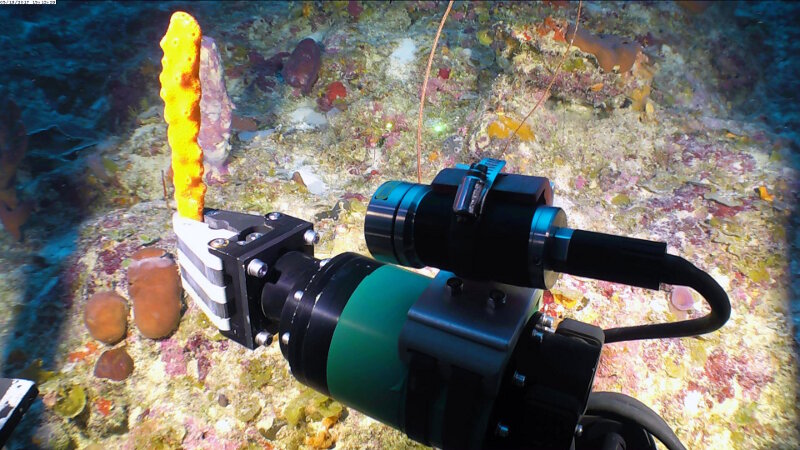
The ROV manipulator grips a Dragmacidon sp. sponge sample for taxonomic identification, collected in the lower mesophotic zone (120 meters depth). Image courtesy of Cuba’s Twilight Zone Reefs and Their Regional Connectivity. Download larger version (jpg, 469 KB).
To confirm our identification of species from the video, we are also able to collect samples with the ROV, although this is quite challenging in the current and on the steep walls. Each site is also unique. For example, the dive at Archipelago “Los Colorados” is the farthest offshore at nearly 20 nautical miles, and not surprisingly, had the greatest abundance of fish. We saw schools of horse-eye jacks, hogfish, and several species of snapper. Several species of grouper were also observed: scamp, black, graysby, and red, which is very rare in Cuba. Many species which are rare in the United States, such as the Blackcap Basslet, are very common in Cuba. Three bat fish camouflaged in these deepest areas surprised us on one of our dives. Lionfish have been observed from 150 meters to shallower depths.
Our impression so far is that these deep reefs are very healthy with little apparent human impact. However, we did see some small pieces of fishing line and nets in the first two sites related to shallow-water fishing. Unlike many shallow coral reefs, we saw little evidence of coral disease or coral bleaching.
Although this is very preliminary, and we have many dives to go, it appears so far that these mesophotic reefs could provide refuge for fisheries and coral species. Cuba is certainly foresighted to already make many of these reefs (currently 25 percent of the shelf) marine protected areas.
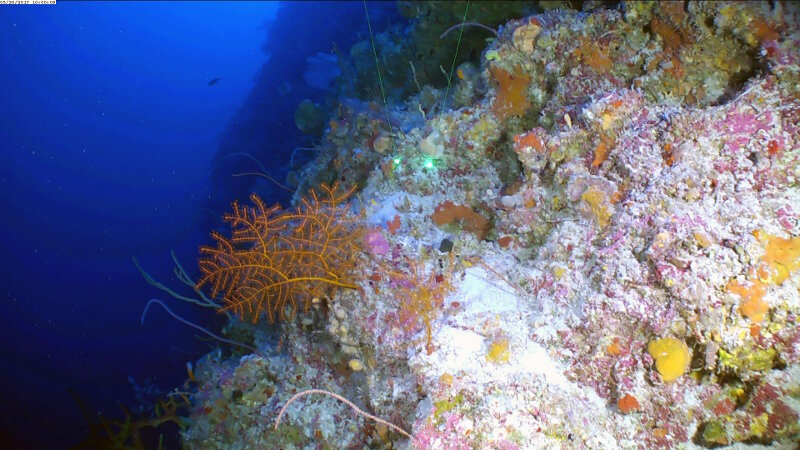
Gorgonians such as Swiftia sp. (orange sea fan) and Ellisella barbadensis (orange sea whip), and black corals such as Stichopathes sp. (spiral whip) are common along the steep walls of the lower mesophotic zone (125 to 75 meters depths). Image courtesy of Cuba’s Twilight Zone Reefs and Their Regional Connectivity. Download larger version (jpg, 457 KB).
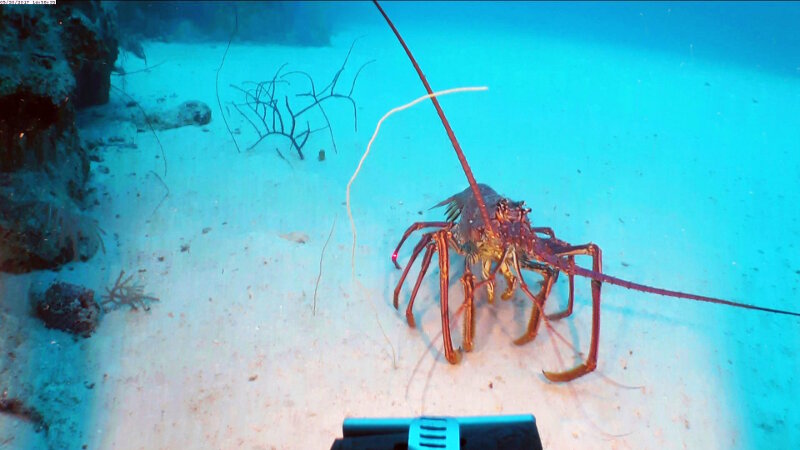
A spiny lobster (Panulirus argus) comes to inspect the ROV during a coral collection in the upper mesophotic zone on the top of the reef wall at 45 meters depth. Image courtesy of Cuba’s Twilight Zone Reefs and Their Regional Connectivity. Download larger version (jpg, 304 KB).